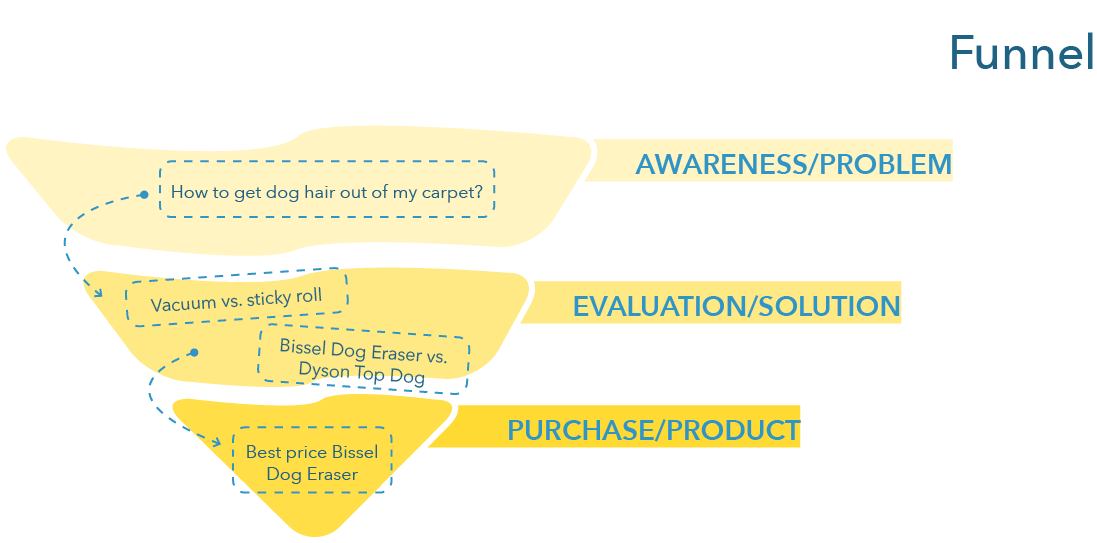RACE and Content Marketing
As we have briefly covered, the RACE framework helps our content strategy by informing the type of content we should be creating for each stage of the framework.
Content marketing professionals typically talk about three types of content: top of the funnel (ToFu) content, middle of the funnel (MoFu) content, and bottom of the funnel (BoFu) content. The funnel represents the purchase funnel, or what we have referred to thus far as the consumer journey (awareness, active evaluation, purchase, and post-purchase).
We can easily map each stage of the funnel with RACE stages and stages of the consumer journey.
ToFu content activities target the awareness stage of the consumer journey and align with the Reach stage. At the awareness stage, consumers are experiencing and expressing symptoms of a need, problem, or challenge they are facing. The content aims at educating them. The need, problem, or challenge that consumers are experiencing can vary in abstractness. For example, they might have lower-back pain and are looking for a solution. Or they might need a pair of new running shoes. Content should thus address problems in ways that match what consumers are experiencing.
MoFu content activities target the active evaluation stage of the consumer journey and align with the Act stage. At the active evaluation stage, consumers are looking to evaluate solutions. Content should thus speak directly to the solutions that consumers can use to solve their needs, problems, or challenges. The goal of the content is to facilitate active evaluation and to serve as a bridge from education to your product or service. It is still important to represent the customer and to limit persuasion efforts, but to balance this with slowly warming consumers to what you have to offer.
BoFu content activities target the purchase stage and align with the Convert stage. At the convert stage, consumers are looking to buy a product. Content at this stage should help consumers evaluate your product or service to persuade them to buy what you are offering over the offer of competitors.
Searches consumers might make throughout the funnel could include the following (Figure 6.6):
- ToFu (awareness/problem): “How to get dog hair out of my carpet?”
- MoFu (evaluation/solution): “Vacuum vs. sticky roll”; “Bissel Dog Eraser vs. Dyson Top Dog”
- BoFu (purchase/product): “Best price Bissel Dog Eraser”
Figure 6.6 Funnel

Examples of content from a firm (e.g., Bissell) to match these searches could be some of the following:
- ToFu: “Everything you need to know about getting dog hair out of carpets and furniture”
- MoFu: “Why vacuums are superior to sticky rolls”
- BoFu: “Save on the Price of Bissell Dog Hair Eraser”
Top of the Funnel
At the top of the funnel, content should educate and entertain consumers based on the need, problem, or challenge they are facing. If people don’t know they need your product or understand what their problem is, it is crucial to educate them on it!
The types of content that typically help here (although this is not a comprehensive nor an exclusive list) include blog posts, webinars, pillar pages, and longer-form content such as comprehensive guides, videos, and infographics.
Middle of the Funnel
In the middle of the funnel, content should help consumers evaluate their options and facilitate that evaluation by educating and entertaining consumers on possible solutions. The firm’s objective at this stage is to start generating leads.
The types of content that typically help here (although this is not a comprehensive nor an exclusive list) include lists (e.g., “Top 10 solutions for lower-back pain”), case studies, how-tos, descriptions of multiple products (aimed at educating, not selling), quizzes to help consumers discover solutions, and other types of templates to help consumers identify solutions for their problems.
Bottom of the Funnel
At the bottom of the funnel, content should inform and persuade consumers about your product or service. The firm’s objective at this stage is to convert leads into customers.
The types of content that typically help here (although this is not a comprehensive nor an exclusive list) include testimonials and reviews, product offers, trials, coupons, samples, demos, free assessments or consultations, persuasive product descriptions, and sales-oriented webinars.
Beyond the Purchase Funnel
Content strategy should not stop at the purchase stage. Beyond the purchase funnel, firms should strive to create content that helps retain and engage customers. This could entail, for example, motivating social sharing, testimonials, and reviews, and encouraging loyalty through online customer events.
The types of content that typically help here (although this is not a comprehensive nor an exclusive list) include customer support and help documentation, contests, and giveaways based on product use, community forums, and strategies to encourage user-generated content. We will cover strategies for this stage in the last chapter of this textbook.
